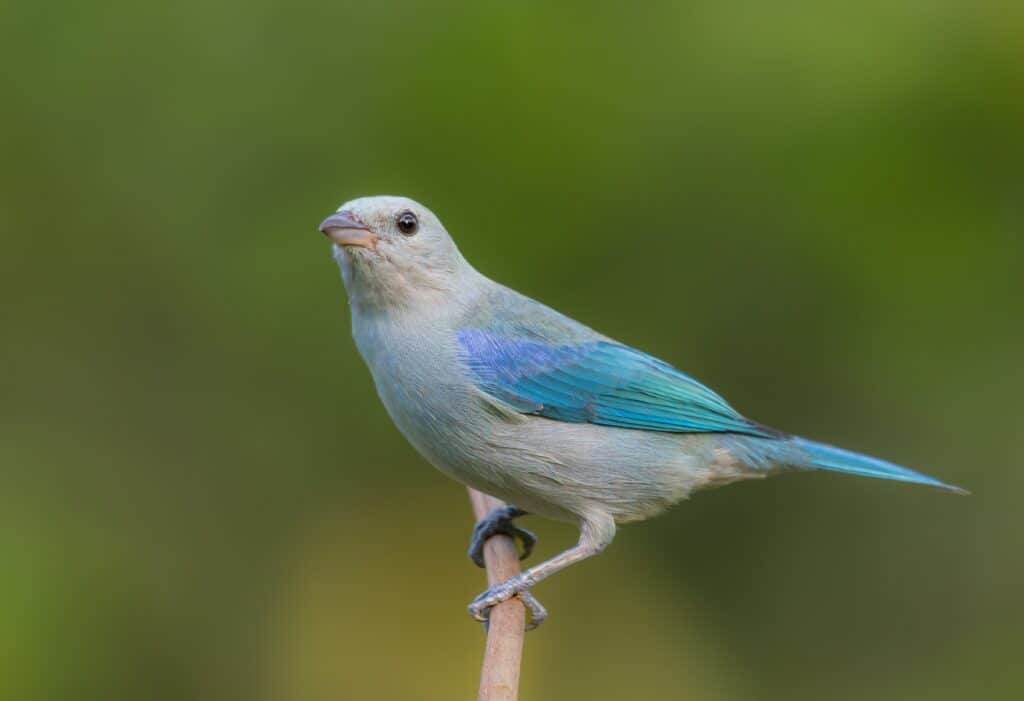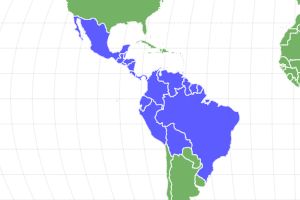Blue Tanager (Blue-Grey Tanager)
Thraupis episcopus
They travel and forage in pairs or groups
Advertisement
Blue Tanager (Blue-Grey Tanager) Scientific Classification
- Kingdom
- Animalia
- Phylum
- Chordata
- Class
- Aves
- Order
- Passeriformes
- Family
- Thraupidae
- Genus
- Thraupis
- Scientific Name
- Thraupis episcopus
Read our Complete Guide to Classification of Animals.
Blue Tanager (Blue-Grey Tanager) Conservation Status
Blue Tanager (Blue-Grey Tanager) Facts
- Prey
- They eat soft fruit, nectar, and insects
- Main Prey
- Fruit
- Name Of Young
- Chicks
- Group Behavior
- Social
- Fun Fact
- They travel and forage in pairs or groups
- Estimated Population Size
- 50 million
- Biggest Threat
- Parasitic infections
- Most Distinctive Feature
- Colored shoulder patches
- Distinctive Feature
- Thick bills, wide necks, and long tails
- Incubation Period
- 14 days
- Age Of Fledgling
- 17 days
- Habitat
- Open areas like forest edges
- Predators
- Carnivorous birds like eagles and hawks
- Diet
- Omnivore
- Lifestyle
- Diurnal
- Favorite Food
- Wild fruit
- Type
- Bird
- Common Name
- Blue-grey tanager
- Number Of Species
- 14
- Location
- Central America, South America
- Nesting Location
- High tree fork surrounded by dense vegetation
- Age of Molting
- One to two years
View all of the Blue Tanager (Blue-Grey Tanager) images!
“They have a squeaky, twittering song.”
Summary
The blue tanager (blue-grey tanager) is a lovely little noisy bird native to Central and South America. They inhabit a wide range of tropical and subtropical environments, choosing to live in open areas close to humans, like parks, gardens, and forest edges. You will often find them munching on soft fruit on the tops of trees, singing their squeaky tune. Learn more about this blue songbird, including where they live, what they eat, and how they behave.
4 Amazing Blue Tanager Facts
- The blue tanager is widely distributed across South America. It is one of their most common tropical and subtropical species.
- There are 14 blue tanager subspecies, and their colored shoulder patches distinguish them.
- These birds are noisy and social, often making squeaky songs as they travel and forage in pairs or groups.
- Their population is increasing due to their ability to adapt well to human habitations.
Where to Find the Blue Tanager
The blue tanager lives in at least 18 countries in Central and South America, including Mexico, Brazil, Costa Rica, Colombia, and Venezuela. This bird is one of the most common in South America’s tropical and subtropical regions, except for the southern tip. They prefer moderately open areas like forest edges, woodlands, agricultural areas, parks, and gardens. You may find it in recent clearings, but you won’t see it deep inside forests. It prefers to stay on the outside near roads and rivers. They frequently inhabit areas in cities and towns, perching on the tops or middle sections of trees.
Blue Tanager Nest
The male and female place their nest in a high tree fork or building crevice surrounded by dense foliage, which is used as the nest base. They build a thick, deep bowl using grass, roots, moss, leaves, and other fine plant material.
Scientific Name
The blue tanager (Thraupis episcopus) is from the Thraupidae family and comprises 12% of neotropical bird species. Their genus, Thraupis, encompasses the tanager family from Mexico to Argentina and Brazil. The specific name (Episcopus) is Latin for “bishop.” The blue tanager has 14 recognized subspecies, differing based on their iridescent shoulder patch color.
Size, Appearance, & Behavior

The blue tanager is widely distributed across South America. It is one of their most common tropical and subtropical species.
©Paul Wittet/Shutterstock.com
The blue tanager is a medium-sized South American songbird, measuring 6.3 to 7.1 inches long and weighing 1.1 to 1.4 ounces. Their wingspan size is unknown, but they feature short, thick bills, wide necks, and long tails. Adults have light blue heads, chests, and underparts, with darker bluish-grey backs, wings, and tails. Blue tanagers also have shoulder patches, which vary in color depending on the subspecies. Most are green, blue, gray, or purple. These birds are relatively social, choosing to travel in pairs or small flocks. They are restless and noisy, and their songs sound like squeaky twittering. This species thrives around human habitations in urban or suburban areas.
Diet
Blue tanagers are omnivores that mainly eat fruit.
What Does the Blue Tanager Eat?
They eat soft fruit (tangerines and papayas), nectar, and insects, like bees, worms, and crickets. They will move into abandoned pastures to find wild fruits, and they may join mixed-species flocks to find food. You can find them munching on their favorite food on the tops or mid-sections of trees.
Predators, Threats, and Conservation Status
The IUCN lists the blue tanager (blue-grey tanager) as LC or “least concern.” Due to their extensive range and enormous, stable population, this species does not meet the thresholds for “threatened” status. Parasitic infections are currently the only threats to the blue tanager.
What Eats the Blue Tanager?
We don’t know their exact predators, but most tanagers are preyed on by carnivorous birds like eagles and hawks. Their nests are also vulnerable to snakes, squirrels, chipmunks, and bigger birds. Blue tanagers may dive and swoop at predators while giving alarm calls.
Reproduction, Young, and Molting
Most tanagers are monogamous during the breeding season, typically between February and July. The female lays one to three white to gray-green eggs with dark markings and incubates them by herself for 14 days. Nestlings fledge the nest around 17 days old. Blue tanager nests are sometimes parasitized by cowbirds, meaning they place their eggs in a tanager nest. Most tanager species are sexually mature and molt for the first time between one and two years old. They can live up to 12 years in captivity. But it’s unknown how long they survive in the wild.
Population
The blue tanager global population is estimated at 50 million mature individuals. This species is experiencing a significant increase due to its ability to adapt well to human habitations. It also doesn’t have any extreme fluctuations or fragmentations in its population.
Similar Animals:
View all 285 animals that start with BBlue Tanager (Blue-Grey Tanager) FAQs (Frequently Asked Questions)
Is there a blue tanager?
Yes! The blue tanager, also know as the blue-grey tanager, is a medium-sized South American songbird.
Where do blue tanagers live?
The blue tanager lives in at least 18 countries in Central and South America, including Mexico, Brazil, Costa Rica, Colombia, and Venezuela.
Where do blue tanagers nest?
The male and female place their nest in a high tree fork or building crevice surrounded by dense foliage, which is used as the nest base.
How big is a blue tanager?
It measures 6.3 to 7.1 inches long and weighs 1.1 to 1.4 ounces.
What does a blue tanager eat?
They eat soft fruit (tangerines and papayas), nectar, and insects, like bees, worms, and crickets.
What threatens the blue tanager?
Parasitic infections are currently the only threats to the blue tanager.
Is the blue tanager endangered?
The IUCN lists the blue tanager (blue-grey tanager) as LC or “least concern.”
Thank you for reading! Have some feedback for us? Contact the AZ Animals editorial team.
Sources
- American Federation of Aviculutre / Watchbird Vol. 42, Available here: https://watchbird-ojs-tamu.tdl.org/watchbird/index.php/watchbird/article/view/3672
- Red List / BirdLife International, Available here: https://www.iucnredlist.org/species/22722527/167302828
- The Online Guide to the Animals of Trinidad and Tobago, Available here: https://sta.uwi.edu/fst/lifesciences/sites/default/files/lifesciences/documents/ogatt/Thraupis_episcopus%20-%20Blue-grey%20Tanager.pdf
- Smithsonian’s National Zoo & Conservation Biology Institute, Available here: https://nationalzoo.si.edu/animals/tanagers

















